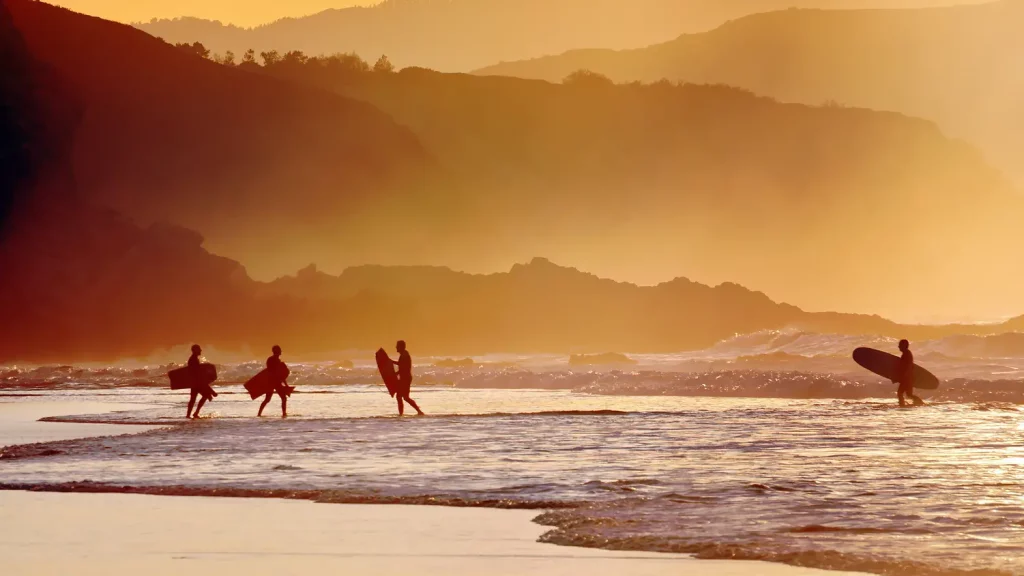Surfing vs Bodyboarding: Which is Better?

Surfing vs Bodyboarding, the two most popular water sports in the world. Both surfing and bodyboarding involve surfing, but differ in equipment and riding style.
We'll take a closer look at the history of surfing vs bodyboarding, exploring the similarities and differences that can be found across the two sports.
Which is Better Surfing vs Bodyboarding
The choice between surfing vs bodyboarding is subjective, with surfing offering versatility and a rich culture while bodyboarding provides accessibility and affordability for all ocean lovers.
Surfers will claim surfing is a better choice due to the skill required to surf, however bodyboarding a charging beach break is just as fun! Personally I believe it comes down to the conditions you are in and the crew you are with in the water!
Surfing vs Bodyboarding Similarities & Differences
| Surfing vs Bodyboarding | Surfing | Bodyboarding |
| Board Types | Surfboard (Foam/Fiberglass) | Bodyboard (Foam/Plastic) |
| Riding Position | Standing On Two Feet | Lying Down On Front |
| Wave Catching Technique | Paddling With Arms | Kicking With Fins |
| Waves Types | Any Wave Size Dependable On Conditions | Any Wave Adaptable To Steeper Drop-ins |
| Riding Style | Vertical & Horizontal Manoeuvres, Carving | Barrel Riding, Spins & Flips |
| Stance | Regular or Goofy | Prone (lying on the board) |
| Equipment | Surfboard, Leash & Wetsuit | Bodyboard, Fins, Leash & Wetsuit |
| Popularity | Globally Popular & Widespread | Less Popular But Still Practiced Globally |
| Price For A Board (New) | $500-2000+ | $80-550+ |
| Difficulty | Difficult To Learn For Beginner | Easy To Learn For Beginner |
| Fitness Required | Endurance In Upper Body To Paddle | Power Required In Legs For Fin Kicks |
| Risk & Safety | Potential For Injury In Larger Waves | Considered Safer With Less Injuries |
| Community & Culture | Diverse Subcultures With Competitions | Diverse Subcultures With Competitions |
| Tricks & Technique | Cutbacks, Aerials, Nose Riding & Barrels | Barrel Rolls, 360s, Inverts & Backflips |
Surfing vs BodyBoarding History
Surfing has a rich history that dates back centuries, with its roots in Polynesian culture. Ancient Hawaiians are credited with developing the sport we recognise today, using traditional wooden boards to ride the waves.
Surfing gained global popularity in the early 20th century and evolved into a global phenomenon, with various surf cultures and competitive circuits.
Bodyboarding emerged in the 1970s in Southern California, primarily as a response to the desire for a more accessible and affordable way to ride waves.
Tom Morey is often credited with creating the first bodyboard, and the sport quickly gained a following, eventually becoming an integral part of the broader surfing culture.
Surfing vs Bodyboarding Which Came First?
Surfing has been around for thousands of years, but bodyboarding as we know it today is a relatively new sport, originating from an ancient form of riding waves on one's belly.
It's important to note that bodyboarding, like surfing, has roots in ancient Polynesian culture. In a way, bodyboards can be seen as a modern take on the traditional Polynesian Paipo Board.
Which is Harder To Learn Surfing vs Bodyboarding?
Bodyboarding is generally considered easier to learn than surfing due to the fact that you don't need to incorporate a popup when riding the wave.
Bodyboarding involves lying on the board and moving your arms and incorporating fin kicks, while surfing involves standing on the board, balancing your legs, and riding the wave.
The learning curve for bodyboarding tends to be shorter, making it easier for beginners to catch waves and get a feel for the sport.
Bodyboarders are able to ride steeper waves with less chance of wiping out producing a higher wave count for beginners.
Both surfing and bodyboarding require practice and effort to improve, however it's important to note the degree of difficulty varies depending on the individual and wave conditions.
Reasons To Learn Surfing vs Bodyboarding
Surfing offers a unique blend of physical fitness and mental relaxation, allowing you to connect with nature as you ride the waves providing the perfect escape from daily life.
Learning to surf opens up opportunities for exploration, adventure, and personal growth as well as becoming part of a thriving global community.
Bodyboarding is a fantastic choice for those looking for a quick and accessible entry into wave riding, as its smaller board size and prone position make it an ideal option for beginners seeking the thrill of riding waves.
With bodyboarding, you can swiftly develop the skills needed to enjoy the ocean, catching waves and riding them in all conditions making it a perfect way to connect with the ocean.
Surfing vs Bodyboarding Wave Differences
Waves suitable for surfing vs bodyboarding differ based on factors such as wave size, shape, and power; surfers typically prefer larger, more powerful waves for manoeuvrability, while bodyboarders may favour smaller, more barrel-like waves that allow for closer contact and easier manoeuvring on the water's surface.
Surfing Waves
Surfers typically favour larger waves with clean, open faces and significant power as this allows for challenging manoeuvres and the opportunity to ride inside the barrel.
Surfers often seek consistent, well-shaped waves that break in one direction, providing ideal conditions for carving and performing tricks.
Bodyboarding Waves
In contrast, bodyboarders tend to prefer smaller to medium-sized waves with a more manageable face height. These waves are more suitable to bodyboarding prone position, making it easier to catch and ride the waves while executing spins, rolls, and other manoeuvres.
Ultimately, wave preferences differ based on the unique riding styles and positions of surfers and bodyboarders; however bodyboarders are able to catch steeper and faster waves without nose diving or wiping out.
Recommendations For Learning
For those looking to excel in surfing or bodyboarding, it's highly advisable to begin with professional lessons from certified instructors. These lessons not only teach proper techniques but also emphasise crucial safety measures, providing a solid foundation for your journey.
Starting in smaller, more manageable waves is recommended even if it is the whitewash as this is where your confidence is born essential for tackling large surf in the future.
Additionally, investing in the right equipment, such as a suitable surfboard, wetsuit (if needed), or bodyboard with fins, will enhance your overall experience and safety.
Consistency and patience are key in both sports, as steady effort and a willingness to embrace challenges in the ocean will result in progress.
Lastly, prioritise safety by familiarising yourself with factors like rip currents, wave etiquette, and local regulations to ensure a safer and more enjoyable experience in the water. Watch this video on surf safety if you're feeling unsure of anything before entering the water.
Surfing vs Bodyboarding What Should You Learn First?
Whether you should learn surfing or bodyboarding first depends on your personal preferences and goals, there is no right or wrong here.
If you're seeking a quicker entry into wave riding and value a more gradual learning curve, starting with bodyboarding is a practical choice. It allows you to become comfortable in the water while mastering wave judgement and body positioning which will come in handy when surfing.
On the other hand, if you're drawn to the challenge of standing on a board and aspire to experience the thrill of riding waves while standing up, then beginning with surfing is a suitable option.
Mastering surfing will require more significant time and effort but offers a unique blend of balance, skill, and the addictive feeling of walking on water.
Ultimately, the choice between learning surfing or bodyboarding first depends on your desired experience and the level of commitment you're willing to invest in mastering either of these exciting water sports.
Can you learn to surf on a bodyboard?
You can't effectively learn to surf on a bodyboard alone because surfing and bodyboarding involve different techniques and different boards.
Surfing requires standing on a surfboard and paddling, while bodyboarding involves riding waves while lying down on a smaller board.
Do surfers like bodyboarders?
Attitudes towards bodyboarders among surfers can vary widely and depend on the individuals involved as well as the location around the world.
In some surf communities, there may be a mutual respect for both sports, as they share a common love for wave riding. with some surfers opting to bodyboard on certain days.
However, there have been occasional tensions due to differences in riding style, wave etiquette, or competition for waves at popular breaks. Surfers can become frustrated when a wave is taken by a bodyboarder known as being snaked, cut off or burned.
Ultimately, the relationship between surfers and bodyboarders often comes down to the culture of the specific surf spot and the attitudes of the people who take to the waters.

Surfing vs Bodyboarding Equipment Needed
Surfing vs bodyboarding share most of the gear needed which is why so many surfers also bodyboard!
To surf, you'll need a surfboard, typically made of foam and fibreglass fitted with a leash to keep it tethered to your ankle.
Depending on water temperature, you may also require a wetsuit or rash guard for insulation and sun protection.
Additionally, surf wax is essential to maintain grip on the board for long surf sessions.
For bodyboarding, the primary equipment needed includes a bodyboard, which is smaller and more buoyant than a surfboard, and a pair of swim fins for added propulsion and control.
A bodyboard leash attached to your arm ensures your board stays nearby in the water. Depending on the water conditions, you might also need a wetsuit for warmth or rash guard for sun protection, similar to what surfers use.
Summing It Up: What To Do Now
Now you know the differences and similarities of surfing vs bodyboarding you can confidently pick which one is for you..and yes both can be for you! Want to learn more surfing terms and culture be sure to check out our list!
If your interested in learning more about surfing discover our many guides that will inform you on your surfing journey. Don't forget to follow us on Facebook & Instagram to stay informed on our amazing surf shots and stories shared from surf creators around the world!
Frequently Asked Questions
Surfing vs Bodyboarding Speeds?
Surfing generally offers faster speeds due to the use of longer boards and the ability to ride larger, more powerful waves, while bodyboarding can be faster in smaller waves due to its lower profile and maneuverability.
What is easier surfing vs bodyboarding?
Bodyboarding is generally considered easier for beginners due to its lower learning curve, making it a more accessible option compared to surfing.
Will bodyboarding help with surfing?
Yes, bodyboarding can enhance wave-reading skills, water awareness, and understanding of ocean dynamics, which can be beneficial for transitioning to surfing.
What is more dangerous surfing vs bodyboarding?
Both sports carry inherent risks, but surfing may pose a higher risk of injury due to the use of longer boards and the potential for collisions in crowded lineups.
Which to start with surfing vs bodyboarding?
For beginners, starting with bodyboarding is often recommended as it provides an easier entry into wave riding and builds fundamental ocean skills.
Benefits of surfing vs bodyboarding?
Surfing offers versatile wave riding experiences with a rich culture and community, while bodyboarding is more accessible, affordable, and allows for easy manoeuvrability.


